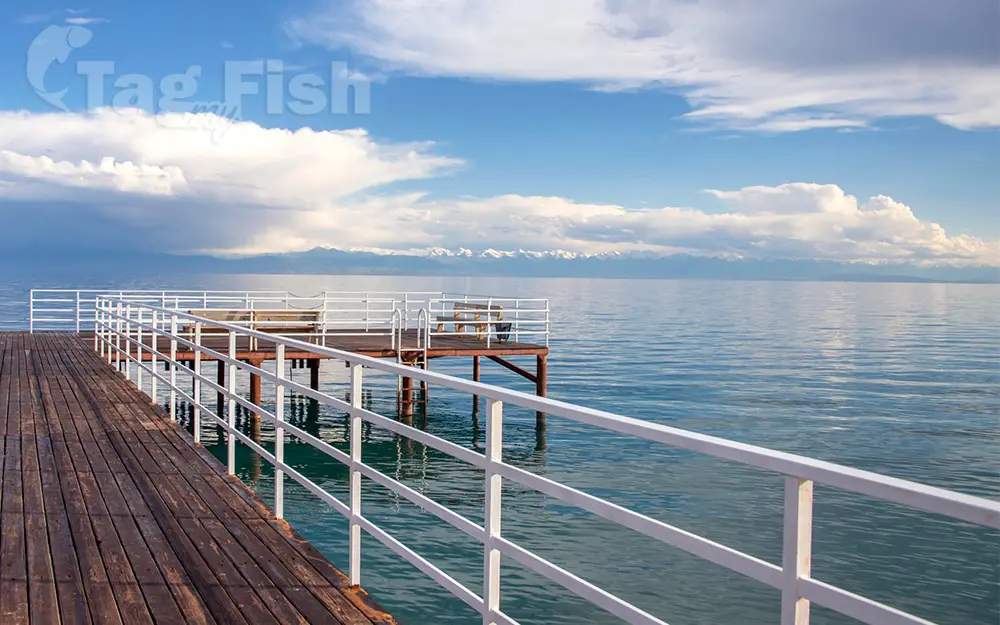Issyk-Kul lake

General data
- Name: Issyk-Kul lake
- Water system: Planet Earth
- Water type: Endorheic lake
- Progression: Planet Earth
- Climates: Continental
- Continents: Asia
- Countries: Kyrgyzstan
Description
Issyk-Kul is an endorheic lake in the Northern Tian Shan mountains in Eastern Kyrgyzstan. It is the seventh-deepest lake in the world, the tenth-largest lake in the world by volume (though not in surface area) and the second-largest saline lake after the Caspian Sea. Issyk-Kul means warm lake in the Kyrgyz language; although it is surrounded by snow-capped peaks, it never freezes. The lake is a Ramsar site of globally significant biodiversity and forms part of the Issyk-Kul Biosphere Reserve. Geography Issyk-Kul Lake is 182 kilometres (113 mi) long, up to 60 kilometres (37 mi) wide and its area is 6,236 square kilometres (2,408 sq mi). It is the second-largest mountain lake in the world behind Lake Titicaca in South America. It is at an altitude of 1,607 metres (5,272 ft) and reaches 668 metres (2,192 ft) in depth. About 118 rivers and streams flow into the lake; the largest are the Jyrgalang and Tüp. It is fed by springs, including many hot springs and snow melt. The lake has no current outlet, but some hydrologists hypothesize that the water filters deep underground into the Chu River. The bottom of the lake contains the mineral monohydrocalcite: one of the few known lacustrine deposits. The southern shore is dominated by the ruggedly beautiful Teskey Ala-Too Range of the Tian Shan mountains. The northern slopes of the range are long and send a considerable flow to Issyk-Kul. Numerous streams taking their rise at the slopes flow together into comparatively large rivers. They deeply dissect the range and flow in wide valleys. On exit from mountains the rivers form large alluvial cones. In eastern part of Issyk-Kul they flow into Jyrgalang river. The Kungey Alatau of the Tian Shan runs parallel to the north shore. The southern slopes of the Kungey Alatau are comparatively short. Therefore, the rivers rising on them are relatively small and do not have a chance to flow together to form larger hydrographic systems. As a result, they separately empty either into Issyk-Kul or into Tüp river flowing along the range. The salinity is approx. 0.6% – compared to 3.5% salinity of typical seawater – and, although the lake level is still currently some 8 metres (26 ft) higher than in medieval times, its level now drops by approximately 5 centimetres (2.0 in) per year due to water diversion. Administratively, the lake and the adjacent land are within Issyk-Kul Region of Kyrgyzstan. Fish species The original fish fauna comprised twelve indigenous species and two subspecies particular to this lake. The long historical and geographical isolation of the lake favored the formation of endemic forms. This fauna is a typical example of the local Central Asian fish complex originating from Central Asian Mountain fauna, which is characterized by the presence of the loaches and cyprinids, with a small addition of leuciscins of Siberian origin. In the native fish fauna of the lake there were no predators although large Naked Osmans Gymnodiptychus dybowskii are said to feed partly on small fish. Strictly endemic fish Schmidt Dace Leuciscus schmidti is present throughout the shallow littoral zone but goes during winter down to 35-40 m. It appears in two forms, a common fast-growing lake form and a slow-growing bay form. The fast-growing form reaches 31 cm, a weight of 650 g, and an age of 11 years. It spawns on stony beds at depths of 0.5-10 m between the end of March (water temperature 5oC) and mid-May. Fecundity is 6,000-65,000 eggs per year. It feeds largely on Characeae, but also on mollusks. The slow-growing form is present throughout the shallows. It reaches a length of 23 cm, a weight of 220 g, and a maximum age of 13 years. It has a similar fecundity and it spawns on the same substrate as the other form, but later. Issyk-Kul Dace was the dominant fish until 1997, when Schmidt Dace became for the first time the most numerous commercial fish in the lake. Issyk-Kul Dace inhabits the whole littoral zone, but is more pelagic than Schmidts Dace. During the winter it is found down to depths 120-150 m, and reaches a maximum body-length of 17.5 cm and weight of 60 g. It spawns in shallow waters at depths between 1-8 m, and feeds mostly on plankton. During recent years the number and distribution of this species have sharply declined. There are two endemic species distributed in mountain waters of Middle and Central Asia. The Scaly Osman (Diptychus maculatus) inhabits high-mountain streams, but enters also into Lake Issyk-Kul. It can grow 50 cm long and weighs up to 1 kg. It feeds on vegetation and invertebrates. The fish spawns in the spring and summer. It has a dwarf form, which lives mainly in the incoming small rivers, and may not live in the lake. It does not exceed 25 cm in length and weighs less than 200 g. The Naked Osman (Gymnodiptychus dybowskii) is found in mountain rivers and lakes. It also appears in two forms: one inhabits in rivers and the other in lakes. Lake living fish appear to have two ecological morphs: a winter lake morph and a summer migratory morph which spawns in rivers with a sandy bottom. Forms and eco-morphs would indicate that taxonomic studies are needed. The winter morph spawns from February to April and its fecundity is 13,000-14,500 per year. The summer morph is smaller, has a lower fecundity of 5,500-12,000, and spawns from April until September. Both morphs are omnivorous. In the lake it feeds mostly on mollusks over muddy and loamy bottoms at 15-30 m deep. The largest Naked Osmans in the lake attain the age of 20 years and can grow up to 60 cm long and 3 kg of weight. It was once important commercial fish in the Issyk-Kul Lake, but there are indications that it is close to extinction. Issyk-Kul Lake and incoming rivers have five indigenous and one alien loach species which are common in littoral underwater meadows, but are also found down to 100 m depth. They feed on benthos, plankton and eggs of other fish. They have never been recorded by name in the catch of the lake except maybe in the “others” component. Subspecies would urgently require taxonomic revision, especially Triplophysa ulacholicus versus Triplophysa u. dorsaloides which are here synonymized. The Issyk-Kul Gudgeon (Gobio gobio latus) spawns in June-July in shallows and feeds on benthos, detritus and fish eggs. It is preyed upon by Spotted Thicklip Loach Triplophysa s. strauchii, Sevan Trout Salmo ischchan and Pike-perch Sander lucioperca . Issyk-Kul Minnov (Phoxinus issykkulensis) is one of the strictly endemic fish species of Issyk-Kul Lake, but unfortunately there is no data on biology or abundance as it has never been important in commercial fishery. Issyk-Kul Marinka (Schizothorax pseudoaksaiensis issykkuli) is an endemic species, which reaches 70 cm and a weight of 8 kg, and spawns from May until mid-July on rocky substratum in shallows near aquatic plants (Figure 3.). Its fecundity is 25,000 per year. It is omnivorous. Between 1985 and 1989 it formed 6% of the fish catch but after 1992 it disappeared completely Indigenous
- Leuciscus schmidti - Schmidts Dace
- Leuciscus bergi - Issyk-Kul Dace
- Phoxinus issykkulensis - Issyk-Kul Minnov
- Gobio gobio latus - Issyk-Kul Gudgeon
- Schizothorax pseudoaksaiensis issykkuli - Issyk-Kul Marinkae
- Diptychus maculatus - Scaly Osman
- Gymnodiptychus dybowskii - Naked Osman
- Triplophysa stoliczkai - Tibetan Stone Loach
- Triplophysa stoliczkai elegans - Tyanschan Loach
- Triplophysa dorsalis - Grey Loach
- Triplophysa strauchii strauchii - Spotted Thicklip Loach
- Glyptosternum reticulatum - Turkestan Catfish
- Triplophysa ulacholicus, including T.u. dorsaloides - Issyk-Kul Naked Loach e
- Onchorhynchus mykiss - Rainbow Trout
- Salmo ischchan - Sevan Trout
- Coregonus lavaretus - Common Whitefish
- Coregonus widegreni - Valaam Whitefish
- Coregonus autumnalis - Baikal Omul
- Tinca tinca - Tench
- Alburnoides taeniatus - Striped Bystranka
- Abramis brama orientalis - Oriental Bream
- Cyprinus carpio - Common Carp
- Ctenopharyngodon idella - Grass Carp
- Hypophtalmichtys molitrix - Silver Carp
- Carassius auratus auratus - Goldfish
- Pseudoraspora parva - Stone Moroko
- Capoeta capoeta capoeta - Transcaucasian Barb
- Triplophysa labiata - Plain Thicklip Loach
- Sander lucioperca - Pike-perch
- Micropercops cinctus - Eleotris or Odontobutid
- Aspius aspius - Asp
- Coregonus albula Vendace (Ryapushka)
- Coregonus peled Peled


